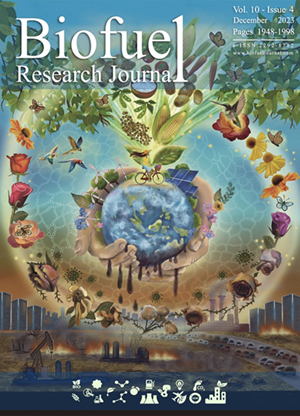A critical review of multiple alternative pathways for the production of a high-value bioproduct from sugarcane mill byproducts: the case of adipic acid
IF 11.9
Q1 ENERGY & FUELS
引用次数: 1
Abstract
Biobased fuels, chemicals, and materials can replace fossil fuel products and mitigate climate change. Sugarcane mills have the potential to produce a wider range of biobased chemicals in a similar approach to bioethanol production, including adipic acid. Multiple alternative pathways for converting simple sugars into adipic acid have been described, with the potential for integration into a sugar mill. The economics and expected greenhouse gas emissions reductions compared to fossil-based adipic acid were investigated in the present study to identify preferred pathways for implementation in sugarcane biorefineries. Nine biobased pathways for adipic acid production were screened for technical performances, resulting in the selection of four preferred options for rigorous comparison, i.e., direct microbial conversion of sugars, and production via cis,cis-muconic acid, glucaric acid, and glycerol as intermediate, obtained from sugars. The minimum selling prices of adipic acid for an attractive return on investment were determined for these pathways, using either A-molasses or a combination of A-molasses and pretreated sugarcane lignocelluloses in biorefineries designed to be energy-self-sufficient. Adipic acid production from A-molasses via cis,cis-muconic acid was the best overall performing scenario with the lowest minimum selling price of USD 2,538/Mt and lowered greenhouse gas emissions (2,325 g CO2 eq/kg wet) compared to fossil-based adipic acid production. The scenarios with combined A-molasses and lignocellulosic feedstock had increased minimum selling prices by 29 to 101% compared to adipic acid production from A molasses via cis,cis-muconic acid.从甘蔗厂副产品中生产高价值生物产品的多种替代途径:以己二酸为例
生物基燃料、化学品和材料可以取代化石燃料产品,减缓气候变化。甘蔗工厂有潜力以类似于生物乙醇生产的方式生产更广泛的生物基化学品,包括己二酸。已经描述了将单糖转化为己二酸的多种替代途径,具有整合到糖厂的潜力。与化石基己二酸相比,本研究调查了经济性和预期的温室气体减排,以确定在甘蔗生物炼制中实施的首选途径。对九种生物基己二酸生产途径进行了技术性能筛选,最终选择了四种首选途径进行严格比较,即直接微生物转化糖,以及通过从糖中获得的顺式、顺式粘膜酸、葡萄糖酸和甘油作为中间体生产己二酸。对于这些途径,确定了具有吸引力的投资回报的己二酸的最低销售价格,在生物精炼厂中使用a -糖蜜或a -糖蜜和预处理甘蔗木质纤维素的组合,以实现能源自给自足。通过顺式、顺式黏液酸从a -糖蜜中生产己二酸是整体表现最好的方案,最低销售价格为2538美元/吨,与化石基己二酸生产相比,温室气体排放量(2325 g CO2当量/千克湿)降低。与A糖蜜通过顺式、顺式黏液酸生产己二酸相比,A糖蜜和木质纤维素混合原料的最低销售价格提高了29%至101%。
本文章由计算机程序翻译,如有差异,请以英文原文为准。
求助全文
约1分钟内获得全文
求助全文
来源期刊

Biofuel Research Journal-BRJ
ENERGY & FUELS-
CiteScore
22.10
自引率
1.50%
发文量
15
审稿时长
8 weeks
期刊介绍:
Biofuel Research Journal (BRJ) is a leading, peer-reviewed academic journal that focuses on high-quality research in the field of biofuels, bioproducts, and biomass-derived materials and technologies. The journal's primary goal is to contribute to the advancement of knowledge and understanding in the areas of sustainable energy solutions, environmental protection, and the circular economy. BRJ accepts various types of articles, including original research papers, review papers, case studies, short communications, and hypotheses. The specific areas covered by the journal include Biofuels and Bioproducts, Biomass Valorization, Biomass-Derived Materials for Energy and Storage Systems, Techno-Economic and Environmental Assessments, Climate Change and Sustainability, and Biofuels and Bioproducts in Circular Economy, among others. BRJ actively encourages interdisciplinary collaborations among researchers, engineers, scientists, policymakers, and industry experts to facilitate the adoption of sustainable energy solutions and promote a greener future. The journal maintains rigorous standards of peer review and editorial integrity to ensure that only impactful and high-quality research is published. Currently, BRJ is indexed by several prominent databases such as Web of Science, CAS Databases, Directory of Open Access Journals, Scimago Journal Rank, Scopus, Google Scholar, Elektronische Zeitschriftenbibliothek EZB, et al.
 求助内容:
求助内容: 应助结果提醒方式:
应助结果提醒方式:


